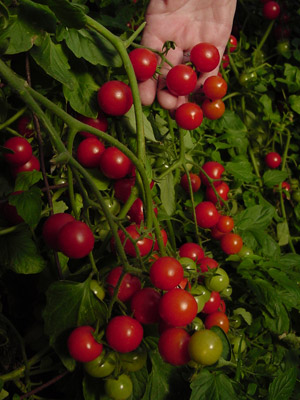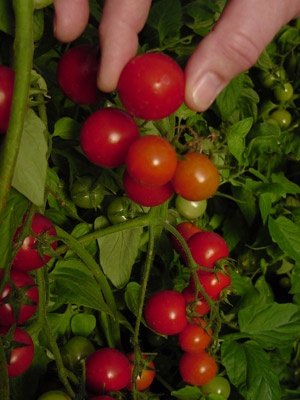|
Horticulturists for the Texas AgriLife Extension Service began testing dwarf-sized (determinate growth) cherry tomato varieties in 2007. Six new varieties were grown under greenhouse and field-grown conditions. In the greenhouse all but one variety produced fruit which is typical of hot house-grown tomatoes, i.e., the fruit was soft, the skin was tough, and the tomatoes were tasteless. However, one of the new varieties tested produced an abundance of sweet-tasting fruit on extremely healthy plants which were less than five feet when grown in 10-gallon containers in the greenhouse. Because the plant is genetically small (determinate), adequate fertilization will be the key to the success of the culture of this plant as the tomato fruit has to be produced and maintained by the branches and foliage of the plant. The key nutrient will be nitrogen. If adequate fertility is not maintained, the tomato bush will be small and produce much less fruit. Mechanical pollination of flowers was not necessary for fruit set as is often necessary when tomatoes are being grown in humid greenhouse conditions.
These same varieties were grown in the field for a spring and a fall crop in 2008. Again the same variety, 'Dwarf Cherry Surprise', produced the sweetest fruit on the healthiest plants which were less than 5 feet high. Standard or non-determinate cherry tomato plants can grow to over 10 feet long.
The 'Dwarf Cherry Surprise' tomato fruit is one-half to three-quarters of an inch in diameter with the sweetest (four times sweeter than a comparable cherry tomato) taste of any cherry tomato every tested by the Texas AgriLife Extension Service. Taste tests of greenhouse and field grown fruit were conducted every three weeks during the growing season by a taste panel consisting of 10 - 12 individuals ranging in age from 60 - 83-years-old. This is the FIRST tomato of any type to be taste-tested by the Extension Service to receive unanimous favorable rating at every testing. HOWEVER, this is NOT TO SAY that every person who grows and/or eats this tomato will heartily approve of its taste and flavor. As my old dearly-departed Mama used to say (Parson's Mama): "There is no accounting for good taste because some folks don't have any taste!!" Everyone's taste for tomatoes is different but this is the closest Extension Horticulturists have come to pleasing the majority of gardeners and even those who do not like tomatoes.
 |
 |
The 'Dwarf Cherry Surprise' tomato is the most naturally disease-resistant cherry tomato ever sold in Texas. It is genetically resistant to the diseases of Verticilum Wilt and Fusarium Wilt (VF) as well as the viruses of Tobacco Mosaic Virus (T) and Tomato Spotted Wilt Virus (TSWV). It is also the first cherry tomato variety to be nematode resistant (N) since the Texas A&M developed variety 'Small Fry' was available over 20 years ago. Each seed of this new super hybrid costs the wholesale grower $ .20 (per seed!!) for first generation (F-1) seed. Second generation seed are available from PLANTanswers.com in the "Parsons' Preferred Seed" section; see 1. Tomato seed at the bottom of the write-up at:
The 'Dwarf Cherry Surprise' tomato was developed to be a commercial cherry tomato variety but was not chosen because of "a bit lower yields and a somewhat softer fruit than other selections". The plant breeders admit that the 'Dwarf Cherry Surprise' tomato does have a superior taste and a much higher disease resistance but the yield and toughness of the fruit is of utmost importance when commercially grown cherry tomatoes are being mechanically harvested and processed for the market. The very "faults" of the 'Dwarf Cherry Surprise' tomato which caused it NOT to be a successful, commercially-grown variety will be the very attributes which will make it a FAVORITE cherry tomato of home gardeners and patio (container) growers.
In addition have you ever wondered how some gardeners always harvest the first tomatoes of the season? In most cases these early bird winners are potting up their plants in containers prior to setting them out in the garden or larger containers when the soil and air temperatures have warmed up enough to support tomato plant growth and fruit setting.
To "pot up" your transplants, fill a one to three gallon black plastic container with a high quality potting soil. Enrich the potting soil with a slow release fertilizer made especially for containers such as a 15-5-10 analysis or Osmocote . If an organic fertilizer is preferred, consider a 4-2-3 analysis at twice the rate. Be generous with the fertilizer; tomatoes, especially 'Dwarf Cherry Surprise', are heavy feeders if you want maximum fruit production. Place the transplants in the container. They can be planted deeply; tomatoes are one of the few plants that can tolerate deep planting. Roots will form along the whole stem. This is especially important if your transplants are leggy or top heavy.
The goal of the "potting up" activity is to maintain the fast growth rate established at the nursery. Place the potted up tomato in full sun in a location out of the wind. The wind can injure foliage and reduce tomato growth. A greenhouse is ideal, but many locations on the patio or the south side of the house also work well.
It is important to keep the tomatoes adequately watered BUT NOT OVER-WATERED. Watering frequency will depend on the water-holding capacity of the potting mix used and the plant size. Check the mix moisture by digging around in the pot—if you feel moisture—DO NOT WATER. Too much watering of young plants can cause roots to rot and you will have to get replacement plants. Also you should apply a dilute water soluble fertilizer at least once a week when watering. The high quality potting soils are very well drained so they usually will not become soggy. Reduce watering when the weather is overcast and/or cool. If the plant is subjected to more than a few hours of sub 40° F temperatures it will stop growing. You will recognize it if the plant stops growing and you see some purplish coloring. This condition often happens if you plant the tomatoes directly into the garden before March 15th.
To maintain the tomato transplant in a growing state move it to shelter when temperatures below 40° F are forecast. That may mean putting the pots in the house on cold evenings.
If you do everything as described, your "potted up" plants will be quite large and may even begin blooming by late March or April when they can be transplanted to the vegetable garden or larger container. NEVER let the plants to be transplanted set more than a few small fruit before moving to a permanent location. If fruit are allowed on transplants, the plants will be stunted when establishing them in the garden location. Do not apply organic mulches around tomato plants until early May when soil temperatures have warmed. Then mulch with an organic hardwood or cedar mulch. If the plant is grown in a container, be sure to water and feed every week with a water soluble 6-12-6 or Peters 20-20-20 fertilizer. Drip irrigation is the best method to water. In about six to eight weeks, you should be harvesting tomatoes and be the talk of your neighborhood.
If you do not have a chance to buy your 'Dwarf Cherry Surprise' transplants at the 2009 San Antonio Rodeo, local independent nurseries will have an ample supply of transplants for sale starting in March.
|



